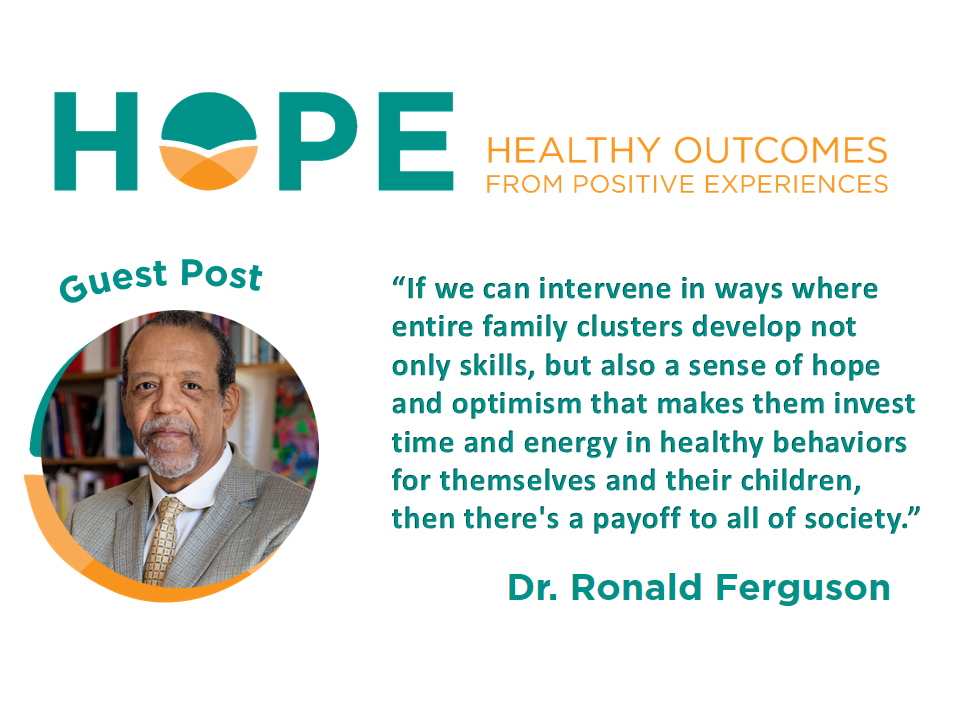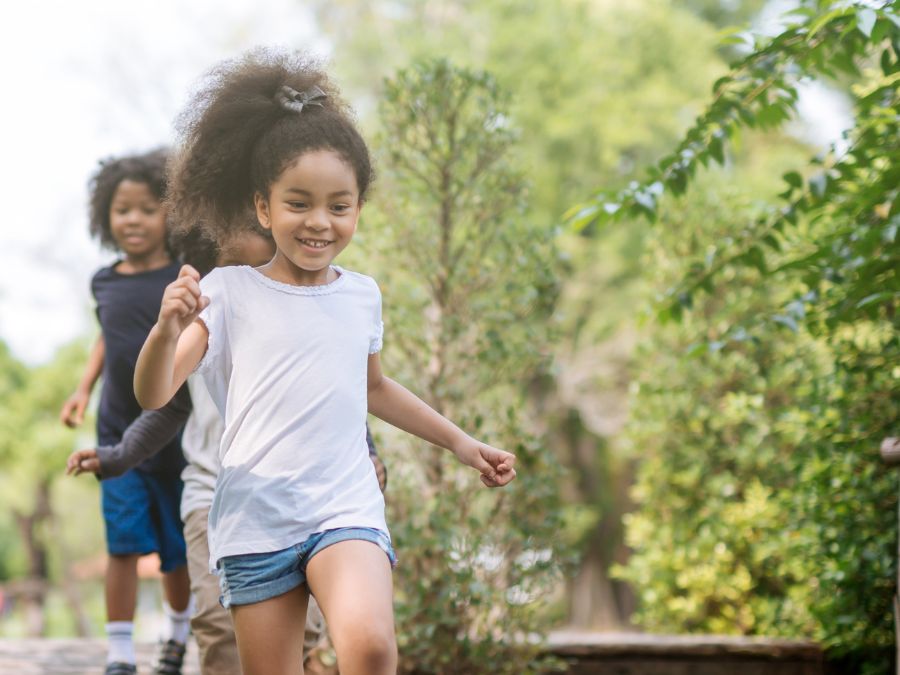
More and more evidence points to the important role positive childhood experiences play in child development. Today’s blog post is based off of an interview with Dr. Ron Ferguson, founder and president of The Basics (a public health approach to supporting social, emotional, and cognitive development of children from birth to age three). In this post, Dr. Ferguson walks us through The Basics and several experiences that benefit child development. Click on the questions throughout the blog post to watch video snippets of the original interview with Dr. Ferguson.
Can you introduce yourself and your work to our blog readers?
I’ve been teaching at the Harvard Kennedy School of Government since 1983. I became an economist to improve conditions in the types of neighborhoods where I grew up. For 20 years, I taught state and local economic development. About halfway through that period, I learned that racial, ethnic, and socioeconomic gaps in reading and math scores measured at the end of 1970s in a national study of adolescents predicted most of the hour earnings gaps 10 years later within the same sample when they were young adults.
That got me interested in education. Then after about a decade of research and consulting on achievement gaps, I came across a nationally representative study showing that cognitive skill gaps are established by the time children are two years old. I set out to find a way to reach parents with the knowledge and supports they need, to give their children the early experiences necessary for preventing such early gaps.
What are the effects of that gap on health and well-being?
Life is very different for people with more of the academic and self-management skills that high achievers tend to develop. It’s easier for them to find and use expert advice to sustain a healthy lifestyle. They find it easier to find friends who have healthy lifestyles and to avoid hanging out with friends who set bad examples. For a variety of reasons, including more stable work schedules, they can organize their lives to have more routines, including for personal health care and self-maintenance. In general, they develop the knowledge, the self-control, the friendship circles, and general lifestyle that promote healthy outcomes.
We’re talking about the child, the parent, the grandparent, sometimes the great grandparents and extended family members. If we can intervene in ways where entire family clusters develop not only skills, but also a sense of hope and optimism that makes them invest time and energy in healthy behaviors for themselves and their children, then there’s a payoff to all of society.
Can you tell readers about The Basics Strategy?
With cognitive skill gaps by the time kids are two years old, the question was, what could we do that could affect entire communities—children’s lived experiences, kindergarten readiness, and school success? I put together an advisory committee that helped distill the scientific literature down into five little phrases that we call The Basics Principles. These capture what developmental specialists argue children should experience early in life. We wanted to saturate the parent’s social ecology with information, social supports, and reminders, to use the five principles:
Maximize Love, Manage Stress, is about the parent attending to their own emotional well-being, managing their own stress, and also expressing love to the child. When children get exposed to too much stress and don’t experience a lot of love and support, they experience greater insecurity and don’t develop the self-management, self-regulation skills that they’re going to need in order to do well in school and life.
Talk, Sing, and Point is a way of taking the first steps toward language acquisition. Children can hear before they’re born. They arrive from the womb already having started to encode the patterns in the language that their parents and family speak. We want people to talk to infants using real language that builds on what the child has already started to develop. The back and forth interaction between a child and a parent can even involve just movements and looks. That back and forth is a brain building exercise. Pointing at what you’re talking about helps infants learn more quickly that words are associated with objects. Singing is just another way of exposing children to language, to rhythm, and to the emotional qualities that come through singing.
Count, Group and Compare, is laying foundations for numeracy and scientific reasoning—helping children to build those parts of their brain that process quantitative information. Even for infants and toddlers, we want to call attention to things that are big or small, heavy or light, near or far. Once children become aware of those contrasts, even their daydreaming, mental activity, can use those concepts to think and reason. Playing grouping games with infants—with toddlers, really—accelerates the pace at which they figure out that numbers correspond to groups of things.
With the fourth Basic, Explore through Movement and Play, we want parents to know that playtime is exploration, learning, and discovery time. They can let the child know their curiosity is welcome; they can amplify ideas that the child might be interested in. Parents also need to recognize that when their child is focused on something, leave them alone. They’re learning to concentrate. Their brain is developing through these activities.
Finally, Read and Discuss Stories, even for infants. The infant is not really following the story, but it’s about early interactions with books. You take the book, you speak with expression, point to the colors, allow the child to turn the pages and chew on the corner of it, if they want to. Gradually, they’ll catch on to the fact that you’re telling a story. The child will want to know, how do you know the word that says that? Then you can start to scaffold more early reading skills. Interacting with the story, you know—“What do you think they’re going to do next? Why do you think they did that?” Gets the wheels turning, helps to build cognition.
Those are The Basics Principles. The idea is to embody those principles in multiple delivery methods, to support parents of infants and toddlers—ages 0 to 3—and remind them to use those ideas. We have a whole array of tools and resources that we use, working through medical centers, libraries, faith-based organizations, homeless shelters, and all the different organizations that we see in the typical community.
We started in Boston, but over the past four years, coalitions have created a local backbone organization in each of about 40 cities around the country. That organization, different in every location, reaches out to hospitals, health centers, libraries, and faith-based institutions, familiarizing them with the tools that we have to reach parents, explaining the benefit of community-wide reinforcement. Service providers are often already covering some of these issues to some degree, but The Basics approach helps to deepen their familiarity, to give them tools with which to be more intentional and systematic, to make it more routine.
We’re doing a project that involves Boston Children’s Hospital using The Basics to train medical residents. One of the tools, for example, is a pad of paper with tear-off handouts for parents, to be given before they leave.
One library-based project comes out of Greenville, South Carolina. The library created book bags with icons for each of the five basics. They gave parents a list of activities that embody The Basics Principles. When a parent comes in and says they’ve done a particular principle or used it 100 times, they get a physical pin to attach to the side of their book bag over the relevant icon. Having all five of your pins is a status symbol—you can imagine people strutting around the library with all five pins on their book bag. Each kind of institution can integrate The Principles into their routines.
We’re developing in a way that supports customization to different communities and partner organizations. Ideas like that library book bag, the pad with handouts for well-baby visits, those come back at us from other cities. We can watch how the same core ideas, the same handouts and other materials, are being applied to the big cities, the small towns, the rural areas.
What are the effects of The Basics?
Baseline and follow-up surveys in our twice-weekly Basics Insights text messaging service indicate changes in caregiving behaviors aligned with The Basics Principles. Mothers interviewed about what they learn from our videos report changes in their children:
One mother said, “I watched the ‘Explore through Movement and Play’ video with my home visitor, so we started going to the park more. I started watching what he was doing and talking to him about it. Now, at home, he’s helping me out with the dishes.” This is a 2-year-old she’s talking about. “He doesn’t watch TV much anymore. He’s just busy playing with stuff.” She was amazed at how this little boy has come alive, now that she’s started to tune into things that he’s discovering and is interested in.
Another mother, who was living in a homeless shelter at the time, said, “I never knew how important it was to read with your child. This one, she’ll be going to school next year, she’s 4, and we read the book, and now she says, ‘Mama, look, that’s the such and such!'” She talks about how her child is initiating the conversation, and she’s so amazed and pleased that her child has opened up in this way. She said, “I try to read more with her now.” She pointed at the 8-month-old and said, “And with her, too.”
We all have an instinct to do these things. What we tell people is that it actually matters that you do. You can help build your baby’s brain. It’s a matter of being more intentional. We’re giving you and your family access to the best of what we know, from the best science, to help you live your best life, because your child deserves it, too.
To engage communities, we say that what none of us can do alone, all of us can do together.
For more of The Basics:
- Click here for The Basics website.
- Click here for The Basics toolkit for parents.
- Click here for The Basics toolkit for organizations.
This interview was conducted, transcribed, and compiled by Chloe Yang.


